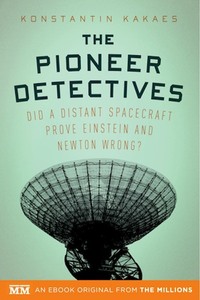Review: The Pioneer Detectivesby Jeff Foust
|
| Kakaes eloquently writes about this scientific mystery, with asides on topics ranging from the Pioneer missions themselves to the plaques they carried to portraits of the key people involved. |
The Pioneer Detectives follows the efforts of Anderson and Turyshev to first confirm that the anomaly wasn’t the result of a software glitch—a group from the Aerospace Corporation independently analyzed the Pioneer data and came up with a similar result—and then to understand what was causing it. There was no shortage of suggestions, which typically fell into two camps. One was that something with the spacecraft themselves, like leaking thrusters or radiation emitted from their radioisotope thermoelectric generators (RTGs), was slowing the spacecraft down. The other—and arguably more exciting—set of explanations revolved around some kind of new physics that the spacecraft’s decelerations had revealed, from modified Newtonian dynamics to, well, other ideas. (“‘Forehead collisions with gravitons,’ theorized a user [of the arXiv preprint server] from Belarus, whose grasp of physics was about on par with his grasp of English,” Kakaes wrote.)
At the risk of spoiling the question posed in the book’s title, the answer came from the former of those two camps: meticulous thermal modeling of Pioneer showed that the spacecraft’s deceleration could be explained by the way the spacecraft radiated heat: “[O]nce the thermal recoil force is properly accounted for, no anomalous acceleration remains,” Turyshev and colleagues wrote in a paper published last year. Newton and Einstein could rest easy.
Even if you’re familiar with the outcome of the Pioneer Anomaly mystery, The Pioneer Detectives is still a fascinating read. Kakaes takes advantage of the emerging “Kindle Single” format of short ebooks to tell a story that would be too long for a magazine article but too slim for a conventional book. He eloquently writes about this scientific mystery, with asides on topics ranging from the Pioneer missions themselves to the plaques they carried to portraits of the key people involved (Anderson, now retired, still believes some kind of exotic physics is at work, despite the conclusive thermal modeling.) It’s a fascinating reminder of how complex and challenging the scientific process can be, and how much work can be involved in determining if that “WTF?” moment will eventually result in an “ah ha!” or an “uh oh.”
